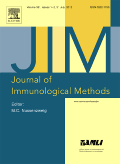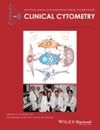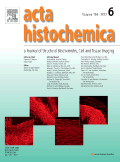
CYTOMETRY PART A
Scope & Guideline
Empowering Science Through Open Access Cytometry Research
Introduction
Aims and Scopes
- High-Dimensional Flow Cytometry:
The journal frequently publishes research on high-dimensional flow cytometry techniques, including the development of complex panels (e.g., OMIPs) that allow for the simultaneous analysis of multiple cell markers, facilitating detailed immunophenotyping. - Imaging Flow Cytometry:
A significant focus is placed on imaging flow cytometry, which combines the quantitative analysis of flow cytometry with imaging capabilities. This allows researchers to study cellular morphology and dynamics in conjunction with fluorescent markers. - Machine Learning and AI Applications:
There is a growing emphasis on the application of machine learning and artificial intelligence methods in cytometry. This includes automated image analysis, classification of cell populations, and enhancement of data interpretation. - Clinical and Translational Research:
The journal often features studies aimed at clinical applications, particularly in cancer research and immunology. This includes the use of cytometry in monitoring disease progression, response to therapy, and the development of personalized medicine approaches. - Novel Cytometric Techniques:
CYTOMETRY PART A highlights the development of novel cytometric methodologies, such as mass cytometry and spectral flow cytometry, which enhance the capability to analyze complex biological samples.
Trending and Emerging
- AI and Machine Learning in Cytometry:
There is a marked increase in the integration of AI and machine learning techniques for data analysis and interpretation in cytometry. This trend is essential for managing the complexity of high-dimensional data generated by modern cytometric methods. - Clinical Applications of Cytometry:
An emerging focus on the application of cytometry in clinical settings, particularly for disease monitoring and therapeutic interventions, highlights the journal's commitment to translational research. - Advanced Imaging Techniques:
The rise of advanced imaging techniques within flow cytometry, such as imaging mass cytometry and label-free imaging, indicates a trend towards more comprehensive cellular analysis, combining quantitative and qualitative assessments. - Environmental and Ecotoxicological Applications:
Increasing publications related to environmental monitoring and ecotoxicology demonstrate the expanding use of cytometry in assessing environmental impacts and biological responses. - Standardization and Best Practices:
A growing emphasis on standardization of methodologies and best practices in cytometry reflects the field's maturation and the need for reproducibility in research findings.
Declining or Waning
- Basic Flow Cytometry Techniques:
There appears to be a declining focus on basic flow cytometry methodologies, as the field moves towards more advanced techniques that integrate imaging and high-dimensional data analysis. - Traditional Immunophenotyping:
While immunophenotyping remains important, traditional approaches using fewer markers are being overshadowed by more complex and informative high-parameter panels, leading to a decrease in publications centered on simpler methodologies. - Plant Cytometry:
Research specifically focused on plant cytometry has become less frequent, possibly due to the increasing specialization of cytometric methods in mammalian systems and clinical applications. - Single-Cell Analysis Techniques:
Although single-cell analysis remains a key area, there has been a noticeable shift towards more sophisticated and automated methods, causing a decline in simpler single-cell techniques that do not leverage these advancements.
Similar Journals

SCANDINAVIAN JOURNAL OF CLINICAL & LABORATORY INVESTIGATION
Advancing clinical insights since 1949.The Scandinavian Journal of Clinical & Laboratory Investigation is a premier publication in the fields of clinical biochemistry and laboratory medicine, published by Taylor & Francis Ltd in the United Kingdom. With an ISSN of 0036-5513 and E-ISSN 1502-7686, this journal has been a vital source of scholarly articles since its inception in 1949, and is set to celebrate over seventy-five years of contributing to scientific knowledge in 2024. Ranked in the Q2 category for both Clinical Biochemistry and Medicine (Miscellaneous), it holds a robust position within the Scopus rankings, with a commendable rank of 77/117 in its discipline. The journal is dedicated to advancing research by offering a platform for high-quality studies that explore the development and application of clinical and laboratory investigations, making it essential reading for researchers, practitioners, and students interested in the latest advances and methodologies in the field. Although it does not currently offer Open Access, a wealth of valuable research insights awaits readers within its pages, highlighting its crucial role in fostering communication and innovation in clinical sciences.

CELL AND TISSUE RESEARCH
Championing Quality Research in Histology and Cell DynamicsCELL AND TISSUE RESEARCH, published by Springer, is a premier journal dedicated to advancing the field of cell biology, histology, pathology, and forensic medicine. With a proud history dating back to its foundation in 1924 and continuing its legacy, this journal has established itself as a vital source for innovative research, facilitating the dissemination of significant findings that contribute to the understanding of cellular and tissue dynamics. Hailing from Germany, the journal exhibits an impressive standing in the academic community with a 2023 impact factor reflected in its category quartiles: Q2 in Cell Biology, Q1 in Histology, and Q1 in Pathology and Forensic Medicine. It ranks notably within multiple Scopus categories, including 32/208 in Pathology and Forensic Medicine and 13/62 in Histology, showcasing its high percentile rankings of 84th and 79th, respectively. Researchers, professionals, and students benefit from its extensive coverage and rigorous peer-review process that ensures the integrity and relevance of its published works, thus making it an essential resource in the scientific community. While it operates under a subscription model, its commitment to quality and impact makes it an indispensable journal for anyone engaged in cellular and tissue research.

JOURNAL OF IMMUNOLOGICAL METHODS
Driving Progress in Allergy and Immunology ResearchJOURNAL OF IMMUNOLOGICAL METHODS, published by Elsevier, is a prominent academic journal dedicated to advancing the field of immunology through innovative methodological research. With an ISSN of 0022-1759 and E-ISSN 1872-7905, this quarterly journal has maintained a steady publication rhythm since its inception in 1971 and looks forward to continued contributions until 2024. Positioned in the Q3 quartile for both Immunology and Allergy as well as Immunology, the journal ranks #150 out of 233 in Immunology and Allergy and #164 out of 236 in Immunology and Microbiology according to Scopus metrics, indicating active engagement within its field despite its developing status. The journal aims to provide a comprehensive platform for researchers and professionals to disseminate high-quality findings, collaborate on foundational methods, and tackle the pressing challenges within immunological research, fostering a deeper understanding of immune responses and promoting advancements in allergy treatments. While it operates under a subscription model, the scholarly contributions offered within these pages are invaluable for those aiming to stay at the forefront of immunological methodologies.

Journal of Hematopathology
Fostering insights into blood-related diseases.The Journal of Hematopathology, published by SPRINGER HEIDELBERG, serves as a vital resource in the fields of hematology, histology, and pathology. Established in 2008, this peer-reviewed journal aims to foster the exchange of knowledge among researchers, clinicians, and students by publishing original articles, reviews, and case studies that contribute to the understanding of hematopathological disorders. While the journal currently ranks in the fourth quartile in various categories including hematology and histology, it positions itself as a platform for emergent research and insights, addressing the evolving landscape of blood-related diseases. Although not an open access journal, it provides crucial access to research findings for professionals looking to stay abreast of developments in pathologic diagnostics and therapeutic strategies. As it continues to grow, the journal remains committed to enhancing the knowledge base and scientific discourse in hematopathology.

CYTOMETRY PART B-CLINICAL CYTOMETRY
Transforming diagnostics with cutting-edge cytometry research.CYTOMETRY PART B-CLINICAL CYTOMETRY, published by Wiley, is a premier journal dedicated to advancing the field of cytometry with a specific focus on its clinical applications. With an impact factor reflective of its influential role in the scientific community, this journal serves as an essential resource for researchers, professionals, and students keen on exploring the latest developments in pathology, histology, and cell biology. The journal holds impressive rankings—Q1 in Pathology and Forensic Medicine and Q2 in Histology—illustrating its critical standing within the academic landscape. Covering a wide array of topics from clinical techniques to innovative applications in cytometry, it aims to disseminate high-quality research findings that contribute to enhanced diagnostic and therapeutic strategies. As an Open Access journal, it ensures that its valuable content reaches a broader audience, facilitating knowledge-sharing and fostering collaborations across interdisciplinary fields. Since its inception in 2002, CYTOMETRY PART B continues to shape the future of clinical cytometry, making significant contributions to both academia and clinical practice.

INTERNATIONAL JOURNAL OF EXPERIMENTAL PATHOLOGY
Innovating Insights in Cell and Molecular BiologyINTERNATIONAL JOURNAL OF EXPERIMENTAL PATHOLOGY, published by Wiley, is a leading peer-reviewed journal dedicated to the field of experimental pathology. With an ISSN of 0959-9673 and E-ISSN 1365-2613, the journal has been a vital resource for researchers and professionals since its inception in 1990, covering a broad spectrum of topics within pathology, cell biology, and molecular biology. The journal's relevancy is underscored by its Q2 ranking in Pathology and Forensic Medicine and Q3 rankings in both Cell Biology and Molecular Biology, as of 2023, reflecting its significant contribution to the scientific community. Although it does not currently offer open access options, readers can benefit from its insightful research articles and reviews that guide advancements in diagnostic pathology and therapeutic strategies. As the journal continues to evolve, it remains committed to facilitating the exchange of innovative ideas and findings that drive progress in experimental pathology and related fields, making it an indispensable platform for scientists, clinicians, and students alike.

Forensic Science Medicine and Pathology
Empowering Professionals with Essential Forensic InsightsForensic Science Medicine and Pathology is an esteemed journal published by HUMANA PRESS INC, focusing on the critical intersections of forensic science, medicine, and pathology. Since its inception in 2005, this journal has provided a vital platform for researchers and practitioners to share innovative studies and findings that enhance our understanding of forensic methodologies and their applications in medical contexts. With an impact factor reflecting its significant contribution to the field, it holds a Q3 ranking in Medicine (miscellaneous) and a commendable Q2 ranking in Pathology and Forensic Medicine as of 2023, indicating its growing influence among scholarly circles. The journal is indexed in Scopus, ranking #76 out of 208 in the Medicine – Pathology and Forensic Medicine category, placing it in the 63rd percentile. Despite it not being an Open Access journal, it remains a crucial resource for professionals, students, and researchers dedicated to forensic sciences and related disciplines. For those seeking cutting-edge research and advancements in forensic methodologies, this journal is an essential addition to any academic repertoire.

INTERNATIONAL JOURNAL OF BIOLOGICAL MARKERS
Connecting Global Minds in Oncology and PathologyWelcome to the International Journal of Biological Markers, a distinguished publication under SAGE Publications Ltd that has been a vital resource in the fields of Cancer Research, Clinical Biochemistry, Oncology, and Pathology and Forensic Medicine since its inception in 1986. With a commitment to disseminating high-quality research, the journal enjoys a robust impact highlighted by its Q2 and Q3 rankings across multiple categories in 2023, as evidenced by its Scopus rankings placing it in respectable percentiles. Based in Italy, this journal serves a global audience of researchers, clinicians, and students eager to keep abreast of the latest discoveries involving biological markers and their applications in medicine. Emphasizing rigorous peer review and scholarly integrity, the International Journal of Biological Markers plays a crucial role in advancing knowledge that can significantly impact clinical practices and enhance patient care.

ACTA HISTOCHEMICA
Pioneering Research at the Intersection of Histochemistry and MedicineACTA HISTOCHEMICA, a prestigious journal published by Elsevier GmbH, is dedicated to advancing the field of histochemistry and its applications within cell biology and medicine. With an ISSN of 0065-1281 and an E-ISSN of 1618-0372, the journal provides a critical platform for the dissemination of high-quality research findings and reviews, integral for both emerging and established scholars. Since its inception in 1954 and continuing through to 2024, ACTA HISTOCHEMICA has maintained a strong commitment to publishing significant advancements in histology and cell biology, as evidenced by its categorization in Q3 for Cell Biology and Histology, as well as Q2 in miscellaneous medicine for the year 2023. The journal ranks favorably in Scopus, holding the 27th rank in Histology and a 200th rank in Cell Biology, highlighting its importance to the academic community. With its headquarters in Munich, Germany, ACTA HISTOCHEMICA continues to attract contributions from global researchers, fostering an international dialogue essential for the growth of knowledge in histochemistry and related disciplines.

European Journal of Hybrid Imaging
Integrating Science and Technology for Better Imaging SolutionsEuropean Journal of Hybrid Imaging, published by SpringerNature, stands as a pivotal platform for scholarly discourse in the rapidly evolving fields of hybrid imaging technologies and methodologies. Since its inception in 2017, this open access journal has significantly contributed to the interdisciplinary interface of biophysics, computer science, molecular medicine, and radiology. With its current standing in the Q2 and Q3 quartiles across various categories, it provides valuable insights and research outputs pertinent to both academic and clinical practitioners. The journal's rigorous peer-review process ensures the highest standards of scholarly integrity, while its open access format promotes global accessibility and encourages collaborative research efforts. Covering a diverse range of topics pertinent to hybrid imaging, the journal serves as an essential resource for researchers, professionals, and students alike, fostering innovation and knowledge exchange within the scientific community.